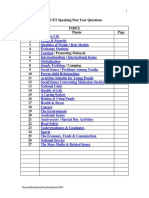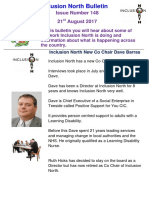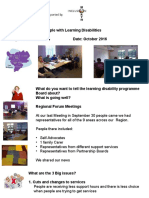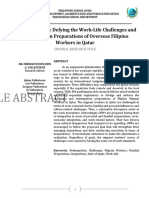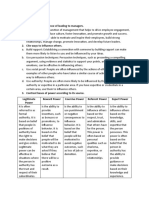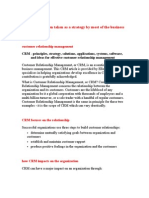Professional Documents
Culture Documents
Final UR BestPractive PBS As
Uploaded by
InclusionNorth0 ratings0% found this document useful (0 votes)
29 views20 pagesFinal UR BestPractive PBS As
Copyright
© © All Rights Reserved
Available Formats
PDF, TXT or read online from Scribd
Share this document
Did you find this document useful?
Is this content inappropriate?
Report this DocumentFinal UR BestPractive PBS As
Copyright:
© All Rights Reserved
Available Formats
Download as PDF, TXT or read online from Scribd
0 ratings0% found this document useful (0 votes)
29 views20 pagesFinal UR BestPractive PBS As
Uploaded by
InclusionNorthFinal UR BestPractive PBS As
Copyright:
© All Rights Reserved
Available Formats
Download as PDF, TXT or read online from Scribd
You are on page 1of 20
Positive Behaviour Support
and Active Support
Essential elements for achieving real change in services
for people whose behaviour is described as challenging
Acknowledgements
Positive Behaviour Support and Active Support Essential elements for achieving real change in services
for people whose behaviour is described as challenging, was written by John Ockenden (United
Response) with assistance from Bev Ashman (United Response), Julie Beadle-Brown (Tizard Centre,
University of Kent) and Andrea Wiggins (The Avenues Group).
We are grateful to Dr Rose Iovannone (University of Florida) for giving permission to use the Multi-Tiered
System of Support Model for schools in the USA.
We are also grateful to the staff and people who are being supported by United Response and The
Avenues Group for allowing us to share their stories and photos.
03
Positive Behaviour Support and Active Support
Challenging behaviour occurs as a result of a complex interaction between the
individual and their environment and has been dened as behaviour of such
an intensity, frequency or duration as to threaten the quality of life and/or the
physical safety of the individual or others and is likely to lead to responses that are
restrictive, aversive or result in exclusion (RCPsych, BPS, RCSLT, 2007)
The report into the systematic abuse of people
with learning disabilities at Winterbourne View
offers the opportunity to nally deliver sustained
improvements which will ensure that people with
learning disabilities and in particular those with
complex needs and challenging behaviour receive
high quality, locally based and effective support.
The report and the associated concordat provide a
framework of planned change across the network
of organisations involved in the lives of people with
learning disabilities (from government to workforce)
in order to promote higher standards of support.
A key feature of this change is the requirement to
implement Positive Behaviour Support.
Positive Behaviour Support is characterised by
educational, proactive and respectful interventions
that involve teaching alternative skills to problem
behaviours and changing problematic environments.
It blends best practices in behavioural technology,
educational methods and ecological systems change
with person centred values in order to achieve
outcomes that are meaningful to the individual and
to his or her family. (Bambara et al, 2004)
Positive Behaviour Support incorporates a
recognition that reacting only to the occurrence
of challenging behaviour, the use of off the peg
responses and of punishment, are limiting and
counterproductive strategies. Rather, it focuses
attention on the development of a constructive,
functionally informed approach to providing
enhancements in the environment and the capacity
of the individual. Consequently it relies on (and is
not just improved by) the development of other
person centred approaches including:
n Person Centred Thinking and Planning
n Effective Communication
n The National Autistic Societys SPELL framework
for supporting people on the autistic spectrum
n Active Support
All of these approaches have a role to play in
the implementation of better support for people
whose behaviour challenges but Active Support is
most closely aligned to Positive Behaviour Support
because of its emphasis on systematic changes to
the whole environment and in the way services
focus on promoting the quality of life of the
people they support, a critical element of reducing
challenging behaviour. In addition, Active Support
is essential for the implementation of the other
approaches listed above.
The purpose of this resource is to demonstrate the
extent to which we believe Active Support underpins
the effective implementation of Positive Behaviour
Support and the role it can play in supporting people
with challenging behaviour. We will also point to
relevant resources.
Positive Behaviour Support is characterised by educational, proactive and respectful
interventions that involve teaching alternative skills to problem behaviours and
changing problematic environments. It blends best practices in behavioural technology,
educational methods and ecological systems change with person centred values in order
to achieve outcomes that are meaningful to the individual and to his or her family
There are 4 essential components which promote engagement in activities and relationships:
Active Support:
Active Support encompasses a range of approaches which aim to provide enough help to enable people to
participate successfully in meaningful activities and relationships so that they gain more control over their
lives, develop more independence and become more included as a valued member of their community
irrespective of degree of intellectual disability or presence of challenging behaviour. To achieve this Active
Support focuses on the skills of staff in enabling engagement and on the capacity of the service to provide
accessible opportunities in a structured and predictable fashion.
Active Support has been shown to be important in determining the quality of life of people with learning
disabilities (Mansell and Beadle-Brown, 2012), and in particular in increasing peoples participation in daily life,
social and community activities as well as increasing peoples skills, adaptive behaviour and choice (McGill &
Toogood, 1994; Jones et al, 2001; Stancliffe et al, 2007; Beadle-Brown et al, 2012; Felce et al, 1986; Mansell
et al, 2002; Mansell and Beadle-Brown, 2012). Research over many years also indicates that Active Support
should be a vital component in the support of people with challenging behaviour (McGill & Toogood, 1994;
Jones et al. 2013).
The primary outcome of Active Support is engagement in meaningful activities and relationships but the way
it looks in practice will vary depending on the individual requirements of the person being supported and the
nature of activity or interaction theyre engaged in.
04
Positive Behaviour Support and Active Support
1
2
3
4
Every moment has potential: Utilising the activities that need to be done (such as housework,
shopping or gardening) and those that are available to do (such as visiting friends or relatives,
playing sport or adult education) as opportunities for supporting people to be engaged throughout
the day. These activities are often done by staff, with the people they serve acting only as non-
participating spectators, if they are present at all. Active Support reverses this condition, so that
people are involved in all the activities of daily living, even (or particularly) when the presence of
challenging behaviour might result in such opportunities being withdrawn.
Little and often: Thinking about activities and relationships as a series of steps so that staff can
identify those parts the person can do for themselves, those that staff can help them with and
those that staff will need to do for them in order for the person to experience success. As a result
staff can start small, enabling people to dip in and out and providing shorter opportunities for
engagement throughout the day rather than solely focusing on single lengthy events.
Graded assistance: Providing the right amount and type of support at the right time too much
and the person will be over-supported and hindered in their independence, control and status; too
little and they will fail. Staff develop the skills they need to ensure the amount and type of help they
provide is constantly adjusted to t the particular activity, step or circumstance.
Maximising choice and control: Looking for opportunities for the person to express their
preferences and be listened to, recognising that choosing within activities and relationships is a
valuable opportunity for experiencing choice and control. Frequently responding to preferences this
way increases the likelihood that the person will learn that making choices makes sense, and will
make more of them.
What is needed for successful implementation
Organising and improving support: Active Support
requires the organisation and allocation of support so
that people experience high levels of predictability and
consistency, as well as coordination of the efforts of
individual staff and the team as a whole to maximise
the planning of support and the extent to which staff
learn from each other.
Practice Leadership: Over the last two decades it has
become apparent that Practice Leadership by front line
managers/team leaders plays a key role in enabling
implementation of Active Support. Research evidence
and direct experience both indicate that no amount of
organisational policy or staff development will have any
impact on levels of engagement in its absence.
Practice Leadership involves the demonstration of good
practice, observation of staff support and feedback on
performance, a coaching process that can be executed
by external experts or peers, but is most effective when
performed by the immediate line manager of staff
concerned. This role necessitates a shift in management
behaviour away from bureaucracy and towards being
an expert practitioner and coach.
The implication of this emerging understanding of how
to implement good practice is that practice leaders
need to be identied, nurtured and encouraged (and
not, for example, punished reexively for inadequate
paperwork) and that expertise in good support needs
to run throughout any organisations line management
structure. While this factor has surfaced in the
implementation of Active Support, related approaches
are likely to depend upon the same conditions if they
are to gain traction in service delivery.
In addition to having the skills to provide Active
Support, staff also need to be motivated to do so. To
achieve this, senior managers must:
n Ensure the alignment of policies and procedures to
Active Support
n Develop a motivational structure that recognises
and rewards staff for enabling people they support
n Communicate clear messages so that staff
understand that this is what they value, over and
above anything else.
05
Positive Behaviour Support and Active Support
06
Positive Behaviour Support and Active Support
1. Assessment and analysis
In order to effectively support people whose
behaviour is challenging, staff need to base their
support and interactions on a comprehensive
understanding of the relevance of the behaviour
for the individual. This needs to take account
of both the persons immediate situation and
environment, including their physical and
mental health, and the broader background
of their entire life. Furthermore, these contexts
need to be understood within the wider range
of physical, social and occupational settings
experienced by the person.
It is important to recognise the impact that staff
beliefs and attitudes have on their responses
to people who present challenging behaviour.
The dominant interpretation of challenging
behaviour is that people displaying it understand
what they are doing and how it affects others.
This unhelpful misattribution of culpability,
commonly arising in the context of emotionally
stressful circumstances, leads to an increased risk
of the use of punishment as staff reach to their
experience of child-rearing or criminal justice, or
for the logic of natural consequences, for ways of
responding.
Therefore, for ethical as well as rational
reasons, objective assessment and analysis are
cornerstones of Positive Behaviour Support.
A range of assessment tools (including direct
observation) are used to gather qualitative and
quantitative information about the person, the
environment and their behaviour from a range
of people who know the person well. Analysis of
the information gathered is then used to produce
a summary (or more realistically, a hypothesis or
best guess) of the current understanding of the
behaviour.
As well as providing meaningful, objective
information to underpin intervention strategies,
this process slows things down and ensures
that those involved explore whats happening
dispassionately, rather than leaping in with quick
xes and/or restrictive practices.
2. Planning
Following assessment and analysis, Positive
Behaviour Support requires the development
of an intervention plan. Again this deliberate
process promotes careful selection from a range
of possible components and mitigates against
a rush for a quick x. Indeed because long
standing challenging behaviour is likely to be
maintained by chronic quality of life deciencies,
Positive Behaviour Support plans must specically
address unhelpful lifestyle and environmental
issues, regardless of the degree to which it seems
that they are connected to the incidence of
challenging behaviour.
Intervention plans should primarily focus on
changing the circumstances of the focal person
so that occurrences of challenging behaviour
become less frequent. Such changes identied
by assessment and analysis will typically relate to
the physical and social environment the person
experiences, and the support they receive. In
addition, the plan may include teaching of new
skills, either designed to replace the challenging
behaviour or to promote coping and self-reliance.
Positive Behaviour Support plans particularly
benet from work that addresses the attitudes
held by, and emotional experiences of, those who
support the person in daily life. Overall, these
proactive strategies should form the bulk of the
intervention plan.
However, reactive strategies need to be developed
for deployment when the behaviour occurs.
Those issues that assessment and analysis have
suggested are directly related to the maintenance
of challenging behaviour (because, for example,
they reinforce it) need to be addressed, but the
main emphasis of Positive Behaviour Support
reactive strategies is that they should bring
about a rapid return to calm normality. To this
end, strategies that might be counter-intuitive
(for example they may continue to reinforce the
behaviour) should be considered if they enable
rapid cessation of the behaviour, but only because
their potentially negative effect is diluted by the
plans more powerful proactive strategies.
Intervention plans should be discussed with
signicant stakeholders, including those expected
to implement them, and should be ethically sound
and realistic in their scope and ambition.
Positive Behaviour Support:
07
Positive Behaviour Support and Active Support
4. Monitoring and review
To establish the effectiveness of intervention,
Positive Behaviour Support requires objective
and comprehensive monitoring and review. Such
evaluation must track a range of pertinent issues
in addition to the relevant aspects of the focal
persons target behaviour because of Positive
Behaviour Supports broader intervention aims,
notably data concerning the quality of life targets
addressed by the plan. In addition, attention paid
to the delity of implementation promotes early
identication of poor or inconsistent execution,
potential deterioration, or relapse. Ongoing
consultation with the focal person and their
supporters enhances authentic and relevant
appraisal of intervention effectiveness.
Positive Behaviour Support also recognises the
importance of providing feedback on the effects
of implementation to those responsible for it,
to support both immediate maintenance and
future developments of the plan. Because of the
attention paid to contextual t, notwithstanding
any potential for wider changes in the persons
circumstances, its likely success, while signicant,
will only be partial. Positive Behaviour Support
plans are always expected to change to reect
changes in the persons life, variation in the
capacity of their support network and to build on
developing success of implementation.
Established and thorough instruments that assist
monitoring and review of intervention outcomes
are commonly in use.
3. Implementation
Positive Behaviour Support recognises that
intervention plans must take account of the
capacity of a persons support network to
implement change successfully. Plans that expect
too much will typically fail and result not only in
continuing damage to the person and others, but
also in disillusionment with the whole approach.
Consideration of the contextual t (the extent
to which the intervention plan is suited to the
circumstances in which it is to be implemented)
is therefore vital. Similarly, the mode of
communication used to inform those with
responsibility for implementation needs to reect
their linguistic and technical understanding.
Careful consideration of such implementation
issues is a prerequisite for the level of consistency
that Positive Behaviour Support requires of any
successful implementation. Attempts to reverse
the consequences of poor or misguided support
are readily undone by occasional returns to such
longstanding practices.
In order to effectively support people
whose behaviour is challenging,
staff need to base their support and
interactions on a comprehensive
understanding of the relevance of the
behaviour for the individual.
08
Positive Behaviour Support and Active Support
Explaining the t:
1. Assessment and analysis
The purpose of Active Support is primarily to
promote engagement and improve the quality of
life of people supported also a primary aim of
Positive Behaviour Support. As such, its techniques
are designed to enable rapid identication of a
range of personal preferences (e.g. for support and
communication style, activity presentation, types
and intensity of activity) and individual strengths
and needs, regardless of the degree of disability
experienced by the person and of the presence of
challenging behaviour. Establishing such individual
preferences is largely an experiential process,
focusing on commonplace everyday possibilities, and
supporting the person to be an active participant
in their own lives. Instead of regarding challenging
behaviour as a reason to withdraw opportunities,
supporters learn how to regulate their approach (for
example through graded levels of assistance) in order
to facilitate successful involvement.
These characteristics are particularly helpful when
supporting people whose behaviour challenges as
they involve the sort of changes in communication
and presentation commonly identied through
functional analysis. Similarly, high levels of ecological
validity and potential generalisation arise from Active
Supports focus on the natural and ordinary fabric of
daily life.
Services providing Active Support will already be
delivering the levels of effective team work and
practice leadership required by Positive Behaviour
Support, and will be skilled in employing observation
and feedback as a key means of establishing crucial
features of individual support.
Engagement is emphasised because of its positive
correlation with quality of life, and because it is
a necessary platform for all other valued lifestyle
aspirations and accomplishments. Accordingly,
Active Support delivers on Positive Behaviour
Supports fundamental commitment to see past any
challenging behaviour to the quality of life beyond.
09
Positive Behaviour Support and Active Support
2. Planning
Active Support recognises that most people live with
others and are served by a number of supporters
who work at different times of the day, and that
these characteristics demand high levels of planning.
Without this, services will usually fail to provide
the help people need and any support offered is
likely to be inconsistent and unpredictable. Critical
consideration is given to the organisation and
sequencing of activity, so that people substantially
get what they need when they need it, and so that
a pattern of events-through-time is established.
In this respect, Active Support addresses, by default,
two of the most commonly identied functions of
challenging behaviour: avoidance of stimuli (events)
that are aversive, frequently because they are
unexpected and therefore difcult to understand;
and the gaining of needed interaction or activity.
Active Support recognises that the development
of predictability is vital in developing peoples
understanding of whats happening, both now,
and next, and in any attempt to increase levels of
engagement in real activity. Similarly, while plans
must be person centred and collaborative, they
must also provide for unforeseen circumstances and
healthy levels of exibility. Services well practiced
in Active Support provide the sort of structure
that works for everybody, while furnishing an
underpinning for the more precise arrangements
required by people whose behaviour is seriously
challenging.
Written plans and proles help staff to deliver styles
of support identied through assessment, and to
focus on enabling successful engagement. This,
in turn, affords opportunities to provide positive
reinforcement for adaptive behaviour, and for the
person to exercise increasing choice and control.
Again, both of these developments mirror goals
of Positive Behaviour Support, and will frequently
provide sufcient change to yield decreasing levels of
challenging behaviour.
3. Implementation
Delivering the support people need, how and when
they need it, requires a range of organisational
provisions. The roles of those who support the
person need to be clear, practice leadership
(particularly modelling and coaching of good
practice) needs to be provided, and managers
need to use a variety of management styles when
working with staff to integrate the plan into their
daily work practices. Active Support expects services
to take account of individual and collective attitudes
and ideologies in designing implementation. These
considerations ally Active Support with Positive
Behaviour Support in its attention to the skills and
abilities of mediators (normally staff) in delivering the
support people need.
No plans can ever predict or allow for all eventualities
so those responsible for implementation need
to be adaptable and exible, taking unforeseen
opportunities for engagement spontaneously and
exploiting opportunities to reinforce behaviour that
is not challenging and to maintain interest and
momentum. Like Positive Behaviour Support, Active
Support is being implemented well when it is made
invisible by the successful and natural lifestyles it
enables.
Effective implementation of Active Support promotes
increased levels of engagement, skills development
and choice making: all common features of effective
Positive Behaviour Support implementations.
4. Monitoring and reviewing
Active Support provides a range of approaches which
promote effective evaluation of implementation
and changes in behaviour. These include the
development of simple monitoring tools that focus
on changes from the persons perspective (and
which may be small in scale), that can be analysed in
supervisions and team meetings, and compared with
evidence from direct observation to give a clear sense
of change over time. This process of evaluation maps
relationships between different factors operating
in a persons perspective. For example, establishing
links between the way a person is supported and
incidents of challenging behaviour, so that plans can
be adapted over time.
Services providing Active Support are accustomed
to the sort of objective evaluation required when
supporting people whose behaviour is challenging
conversely, staff who have not implemented Active
Support frequently struggle to gather and process
evidence with sufcient rigour to be useful to
Positive Behaviour Support interventions.
10
Positive Behaviour Support and Active Support
Illustrating the Fit:
Fig 1 The relative requirement for Tiers 1, 2 and 3 interventions
Tier 1
Tier 2
Tier 3 Few
Some
All
An analogy from schools in the USA that provide
education for children with learning disabilities and
challenging behaviour serves to illustrate the broad
relationship between Active Support and Positive
Behaviour Support. Sugai et al (2000) describe
interventions in such settings as requiring three tiers
of focused staff activity. Tier 1 represents the universal
routine teaching-based running of the school and
classroom with an emphasis on structure, support,
effective communication, consistency and positive
relationships. Because it provides facilitating the
mediator for effective education and interaction, no
child or adult is excluded from the expectations and
benets of Tier 1.
Where more support is required, Tier 2 addresses
specic challenging behaviours, providing more
targeted attention to small groups of students and
interventions for particular areas of concern alongside
Tier 1 strategies. The goal of Tier 2 support is to avoid
the cost and intensity of Tier 3 intervention.
However, and as necessary, Tier 3 is incrementally
added in response to the sort of persistent and intense
challenging behaviour that typically causes signicant
disruption to the environment. It provides for complex
and labour intensive analysis and the development of
a detailed, multi component intervention plan focused
both on the decrease of problematic behaviours and an
increase in more acceptable alternatives.
The relationship between these three tiers is represented
in Fig 1. The multi tiered system of behavioural support
is conceptualised as a continuum. When Tier 1 is
implemented for all, then Tier 2 is only required for
some children, while only a few need Tier 3.
Tellingly, Sugai and colleagues make the point that
when all three tiers are present and available, Tier 3
support is indeed only required by a few, but in the
absence of the everyday facilitation provided by Tier 1
(and to some extent Tier 2), many more children require
the intense and costly support of Tier 3 interventions.
In adult services for people with learning disabilities
whose behaviour challenges, the parallel is clear. Active
Support is the equivalent of Tier 1 and should be a
requirement for all. As an adjunct, Positive Behaviour
Support that is individual and focused, but not highly
technical (at the Tier 2 level of intervention), can be
provided for some people by those who support them
everyday, while the few whose complexities require
help from separate specialist services should receive Tier
3-like interventions.
This intensive and expensive support that should be
needed only by a few (those represented by the tip of
the triangle) is however required by many more people
in the absence of Active Support.
11
Positive Behaviour Support and Active Support
Fig 2 Active Support and Positive Behaviour Support
Conclusion
Active Support shows itself to be an essential
adjunct to Positive Behaviour Support in the search
for improved support for people whose behaviour
challenges for two reasons:
1. Challenging behaviour is generally a rational,
normal response to adverse circumstances, not
an aberrant, perverse anomaly. Active Support
recognises the common need for predictability, for
sensitive and exible help to engage successfully
in everyday activity, to make choices and to exert
control over how we lead our lives day to day. When
these lifestyle (or quality of life) features are absent
or impaired, all human beings respond by behaving
in ways that would be described as challenging.
Consequently, Active Support provides conditions
in which challenging behaviour generally decreases,
particularly by improving peoples quality of life:
helping people to develop new skills, gain self-
condence and experience choice and control. For
many individuals, Active Support delivers enough
of what they need to render challenging behaviour
unnecessary.
Whilst a number of individuals will require the
intensity and precision of Positive Behaviour Support,
the majority would benet signicantly (and
sufciently to minimise challenging behaviour) from
the implementation of Active Support.
2. Where Positive Behaviour Support is needed, its
effective implementation is dependent on a number
of service characteristics that are inherent to Active
Support, eg:
a. Objective assessment, analysis, monitoring and
evaluation
b. Coherent and realistic planning
c. Implementation that is exible and sensitive to
the critical role of mediators
d. A level of structure (of time, resources and
accountability) that facilitates considered,
rational and proactive support
Positive Behaviour Support that is implemented
in circumstances where Active Support is already
embedded in working practices and service
ethos can reasonably expect to exploit those
characteristics, and achieve therapeutic effect.
Positive Behaviour Support that is implemented
without Active Support is likely to require high levels
of external support and scrutiny if it is to have any
impact on the lives of those it is intended to reach.
Few
Some
All
Positive Behaviour Support
requiring external support
and monitoring
Positive Behaviour Support
provided autonomously by
Support Teams
12
Positive Behaviour Support and Active Support
Recommendations
1. Department of Health
It is important that the
government should provide
leadership around good
practice and recognise
that staff need to have
more basic skills in order to
implement Positive Behaviour
Support well. There needs
to also be a recognition
that if services for people
with learning disabilities
provided more person
centred support generally,
the need for expensive
specialist challenging
behaviour services would
reduce (although possibly not
disappear entirely). Therefore,
we recommend that the
Department of Health should
recognise Active Support as
an essential strand of good
support and that it should
be included by default in
expectations of services
for people with learning
disabilities and autism more
generally. As part of this,
a clear denition should
be given as to the nature
of Active Support and the
training and support staff
need to receive. The research
is clear that just taking staff
out for a days classroom-
based training is not sufcient
to implement Active Support
in practice there has to
be an element of in situ or
interactive training that helps
staff to apply knowledge
from training through
observation, feedback and
modelling to shape up their
skills.
13
Positive Behaviour Support and Active Support
2. For Service Providers
Organisational awareness of Active Support
The implementation of person-centred approaches
requires a whole organisation approach. All senior
managers should familiarise themselves with the
principles and elements of Active Support and
what is needed for implementation, as well as
understanding the extent to which it supports
the implementation of Positive Behaviour Support
and other person centred approaches. There are
a number of resources listed at the end of this
document which provide more detailed information.
Training
When seeking or funding training on Positive
Behaviour Support for staff, service providers
should either ensure that the Positive Behaviour
Support training includes a substantial component
focusing on Active Support OR should seek to
provide staff with additional training on Active
Support. Classroom based training should include,
at the very least, information about engagement
in meaningful activities and relationships and why
engagement is important in promoting quality of
life and reducing challenging behaviour, and about
the four essentials of Active Support. It should
also cover the importance of helpful routine and
consistency. However, it is very important that staff
also receive the hands on training to gain the skills
and condence to try. Ideally, all staff should have
training, as a cascade model relies on front-line
managers having substantial expertise and skills to
pass the information on.
If staff are receiving training in Active Support
independently of Positive Behaviour Support
training, the links with other person centred
approaches including Positive Behaviour Support
should be made clear.
Practice leadership
Service providers need to ensure that the front
line managers whose role it is to lead the practice
of their team are skilled in Active Support as well
as Positive Behaviour Support, and have practice
leadership as a clearly dened part of the job.
They should have the time, training and support
to observe, model and coach their staff. Training
for frontline managers should support them to
make the links between all aspects of their job role
thus promoting a holistic approach to their job
and to the support they give staff. They should be
supported to develop the skills to provide feedback
and encourage reection and problem solving with
respect to both good and poor practice to individual
staff and to teams in both supervision and team
meetings.
Aligning policy and procedures
Policy and procedures need to be aligned so that
they are supportive of person-centred action such
as Active Support and Positive Behaviour Support.
Organisations need to strike a balance between
monitoring systems and processes and attending to
a broad range of outcomes for people supported
and the quality of the support staff provide on a day
by day basis. Senior managers should ensure that
they also know what good support for challenging
behaviour looks like. They should visit services
asking the right questions and looking at relevant
components of support. In this way, they can
develop appropriate motivational structures that
will maintain good practice. Auditing processes in
particular must include observational approaches.
Learning from other organisations
In addition to acquiring and reading the resources
available, senior and middle managers should visit
and learn from the experience of other organisations
who have already taken an organisation-wide
approach to implementing person centred
approaches.
The implementation of person-
centred approaches requires a whole
organisation approach.
14
Positive Behaviour Support and Active Support
3. For families and friends
Families and friends of those who are supported
by services can play an important role in
improving the quality of support for their loved
one. If they are aware of the importance of Active
Support and Positive Behaviour Support this puts
them in a stronger position to ask care managers
and services themselves for evidence that such
person centred approaches are provided.
Organisations have a responsibility to
encourage families and friends to increase their
understanding of good practice and should,
for example, invite them to attend training on
Active Support as well as Positive Behaviour
Support. Families and friends should expect to be
welcomed and encouraged in this endeavour.
For people on individual budgets where families
and friends support the recruitment of staff, an
awareness of Active Support will support the
process of recruiting staff with the right attitudes
and preferably the right training and experience.
4. For commissioners and care managers
All commissioners should make themselves aware
of what good person centred support looks like
for people with learning disabilities.
When commissioning services for someone with
a learning disability and challenging behaviour,
commissioners should choose services that they
know provide good Active Support in alliance
with Positive Behaviour Support. Commissioners
may use their previous experience to guide their
choice but will often need to visit to observe
current staff support in services familiar to them,
and should always do so when considering
services they have not visited before.
The provision of both Active Support and Positive
Behaviour Support will be easier to achieve
in small dispersed settings that are designed
around the needs of the individuals they support.
Such support should be included in service
specication and/or contracts for people who
may show behaviours described as challenging.
Individual budgets should include funding for
training staff not only in Positive Behaviour
Support but also in Active Support; as time goes
on it is hoped that the workforce will become
more skilled at person centred approaches in
general.
Local authorities should consider the provision of
training and awareness raising sessions on Active
Support for all stakeholders including families
and those who are personal assistants employed
on personal budgets. This is especially important
when funding care packages for people with
challenging behaviour.
The provision of both Active Support
and Positive Behaviour Support
will be easier to achieve in small
dispersed settings that are designed
around the needs of the individuals
they support.
15
Positive Behaviour Support and Active Support
5. For inspection and quality assessment
agencies
Inspectors (or anyone else responsible for
monitoring the quality of social care and health
services) need to be familiar with what good
practice for people with learning disabilities
looks like and what it is possible to achieve
in terms of quality of life, despite challenging
behaviour, autism, or other complex needs.
They should receive basic awareness training in
Active Support and Positive Behaviour Support
and lead inspectors of learning disability services
should have more extensive knowledge of such
approaches.
They need to have the skills to observe and to
identify whether people are engaged in a range
of meaningful activities and relationships, and
to identify whether the focus of behaviour
strategies used is on promoting quality of life or
simply on managing behaviour. They need to be
able to check whether any paperwork completed
is matched by what is seen in practice.
If inspection or quality monitoring agencies are
looking at the lived experience of people in the
services, observing and providing feedback to
services related to Active Support, then services
are more likely to focus on providing good
support to people, rather than meeting perceived
requirements to complete paperwork that often
does not reect what really happens in the lives
of the people supported.
6. Skills for care
Active Support should be a core competency
for all staff in learning disability or autism
services. There also needs to be a recognition
that it should be both a verbal and a practice
competency. Other person centred approaches
such as SPELL, alternative or augmentative
communication or Positive Behaviour Support
should also be taught at a basic level with
options for people to take it to a more advanced
level if they are supporting people who need
such approaches. This would have a substantial
impact on the occurrence of behaviour that
challenges for many people and reduce the need
for specialist challenging behaviour services.
Active Support should be a core
competency for all staff in learning
disability or autism services.
T
h
i
s
p
h
o
t
o
d
e
p
i
c
t
s
m
o
d
e
l
s
w
h
o
d
o
n
o
t
h
a
v
e
a
d
i
s
a
b
i
l
i
t
y
.
16
Positive Behaviour Support and Active Support
Some examples of the impact of Active Support
Geraldine
Geraldine is a middle aged lady who lives with three other
people in a suburb of a city in the south of England. She
has a moderate learning disability and a visual impairment,
and lived for some years in a number of small institutions
before moving to her current home. Geraldine is often
charming, considerate and affectionate. She has a number
of skills and enjoys interacting with others. However, she
frequently experiences episodes of acute distress, shouting
and swearing, jumping up and down, banging her feet
and hands hard on the oor, and scratching her face so
repetitively that it bleeds. Staff struggle to support Geraldine
when she behaves in this way and nd that their reactive
strategies have little effect beyond supporting her to calm
down a little, before the next episode.
It had been suggested that Geraldine was the victim of abuse
in one of her previous placements, so attempts were made
to establish an intervention that would help her recover
from the psychological damage involved. Sadly, despite a
number of attempts involving members of the local learning
disability team, no-one was able to make any progress in this
area because of Geraldines cognitive impairments. Other
proactive strategies within the Positive Behaviour Support
plan included teaching her coping skills (so she can better
deal with conict with her co-tenants) and improving lighting
and the use of visual contrast in the dcor and fabric of her
home so that she can nd her way around better. None of
these interventions had an impact on the frequency, duration
or intensity of Geraldines challenging behaviour.
However, a new manager with expertise in Active Support
was appointed to lead practice in Geraldines service. One
of his rst acts was to change the way that staff support,
and the events of the day, were planned and organised. In
particular, he focused on increasing the predictability of what
happened when, and with whom. Some of this involved
scheduling existing activity in a more structured way, but
even more predictability was enabled by increasing the
amount that Geraldine and her co-tenants were involved
in everyday activities around their home things that staff
might have done by themselves in order to be kind to
the people they supported. Rapidly, Geraldines challenging
behaviour diminished to a very low level (and when it
happened it was usually because staff had forgotten to
maintain the agreed structure).
Furthermore, many of the old strategies the service had
tried now proved effective they werent wrong, they just
werent part of something that enabled Geraldine to make
sense of her world. Active Support brought the structure and
coherence that she required.
17
Positive Behaviour Support and Active Support
Lucy
25 year old Lucy relishes her independence. As well
as holding down a part-time job, she volunteers,
has a boyfriend and lives in her own at. Lucy was
receiving one hours support at both ends of the
day, plus an hours support a week to go shopping.
Although the aim of this support was to teach her
the life skills she needed to live independently, she
was actually struggling to keep her house in order.
Rather than teaching her how to cook, the staff
were cooking microwave meals for her. She was
hoarding everything, from leftovers to rubbish. This
behaviour was beginning to put her tenancy at risk,
and she would respond with verbal aggression to
any attempts staff made to help her.
We decided the best way of instigating a change in
Lucys lifestyle was to sit down and discuss things
with her and her parents. One thing that wasnt
working was the structured To do list she had
for everyday things, on which different jobs were
allocated for every day. Lucy leads a very busy life so
having a specic job for each day didnt work. We
developed a new one which simply listed all of the
things that needed doing that week, and asked her
to tick off each one as she did it.
As well as enabling Lucy to take control of looking
after her home in her own way, we also developed
a routine with Lucy that complemented her lifestyle
more naturally. For example, Lucy was sometimes
missing her morning bath, because she worried
about missing her bus or being late on the days she
worked. So instead, we suggested she adapt the
routine so that she bathed in the evening on those
days.
When it came to helping Lucy with mealtimes,
we agreed to help her write a weekly menu and
shop only for what she needed. This cut down the
amount of out of date food she had in the fridge
and reduced the amount of waste in the rubbish
bins. We also suggested she write dates on any
plastic tubs of leftovers so she could control how
long to keep things for.
When it came to cooking, we realised all Lucy
needed was to be given the opportunity to take
control: she was so used to things being done for
her, rather than with her, that she had never had the
condence to give it a go.
After one month of changes, we met with Lucy and
her parents once more to review how things were
going. The new routine we had developed with Lucy
was working and her house was now much more
comfortable. She was getting on so well, in fact, that
when we arrived to help prepare dinner, she had
already done it without us! We had noticed that on
the days her boyfriend stayed over, she did not really
need or want us around. She enjoyed looking after
him and would naturally get the at looking nice
before he came. So we decided, with agreement
from her parents, to reduce the hours of support we
provided.
On the surface, the support weve given Lucy may
seem very minor. But Active Support is almost always
about the little things that make a big difference in
giving people control to do things for themselves.
With Lucy, it was more important to talk her through
what to do and why, rather than show her through
actions. She needed routine, but it had to be one
designed around her. And it had to be consistent to
work.
Lucy is now condent and proud of what she can
do for herself. And she isnt scared to be assertive
and tell us what she wants. She has become the
independent woman she always wanted to be.
When it came to cooking, we realised all Lucy needed was to be given the opportunity
to take control: she was so used to things being done for her, rather than with her,
that she had never had the condence to give it a go.
18
Positive Behaviour Support and Active Support
Simon
Simon has a severe learning disability, epilepsy and
autism. For half of his 60 years, Simon has lived
in institutions, often in locked wards and always
experiencing limited opportunities for interaction
and activity. Simons challenging behaviour (pushing
and barging into people, grabbing peoples wrists
and pulling them, running off, throwing himself
onto the oor both in and out of the house) meant
that his life was very impoverished.
Even when he moved into the community, Simon
was never really involved in his personal care, home
or neighbourhood life: for long periods, he would
sit alone in his bedroom. When they happened,
activities in the community were always with 2:1
support and were difcult as Simon would run
away, barge people and display other challenging
behaviours.
Simon doesnt use words to communicate: his
challenging behaviour tells us when he cant cope
and needs to escape from whats happening.
The Positive Behaviour Support plan we developed
indicated that his behaviours were probably
triggered by not knowing what was coming next
or what was expected of him. In response, Simons
support team used the Active Support principle of
Little and often to guide their work with him.
In particular, they concentrated on preparing and
presenting activities in such a way that they would
make sense to Simon and ensured that new activities
progressed at a pace that he could handle.
The best example is the way we supported Simon
in the community. We started from scratch and to
begin with we just concentrated on going for a
short walk in a country park. We reasoned that this
was likely to give Simon the best chance of doing
something successfully, and we made sure that staff
presented this activity consistently (we always went
by the same route to the same park, for example)
and that we didnt change our expectations until
Simon was clearly condent about what was
happening.
And gradually Simon has become more condent,
so we have carefully expanded the range of options.
He now visits several different country parks in the
area, but also walks into town to do his banking
and shopping. By using the principle of little and
often, we have supported Simon to do things he
would never have done successfully before, and all
without any instances of challenging behaviour. As
a consequence, weve been able to reduce the level
of stafng to 1:1 for most community activities,
which, given his previous life experiences, is a huge
achievement for everyone.
Resources
Ashman, B, Ockenden, J, Beadle-Brown, J and Mansell, J (2010) Person-centred active support: A handbook.
Brighton: Pavilion Publishing.
Beadle-Brown, J, Richardson, L, Ashman, B, Ockenden, J and Mansell, J (2012) Promote Active Support
(LD302, LD303). Brighton: Pavilion Publishing.
Mansell, J and Beadle-Brown, J (2012) Active support: enabling and empowering people with intellectual
disabilities. London: Jessica Kingsley Publishers.
Mansell, J, Beadle-Brown, J, Ashman, B and Ockenden, J (2005) Person-centred Active Support: A multi-media
training resource. Brighton: Pavilion Publishing.
Allen, D and Baker, P (editors) (2013) International Journal of Positive Behaviour Support Special Issue
dening positive behaviour support. BILD, International Journal of Positive Behavioural Support, 3,2.
References
Bambara, L, Dunlap, G, and Schwartz, I, (eds) (2004)
Positive behavioural Support: Critical Articles on Improving
Practice for Individuals with Severe Disabilities. Austin,
Texas: Pro.ed
Beadle-Brown, J, Hutchinson, A and Whelton, B (2012)
Person-centred active support increasing choice,
promoting independence and reducing challenging
behaviour. Journal of Applied Research in Intellectual
Disability 25 (4), 291-307
Felce, D, de Kock, U and Repp, A (1986) An eco-
behavioural comparison of small community-based
houses and traditional large hospitals for severely and
profoundly handicapped adults. Applied Research in Mental
Retardation 7, 393-408
Jones, E, Felce, D, Lowe, K, Bowley, C et al (2001)
Evaluation of the dissemination of active support training
and training trainers. Journal of Applied Research in
Intellectual Disabilities 14 (2), 70-99
Jones, E,; Lowe, K, Brown, S, Albert, L, Saunders, C, Haake,
N, Leigh, H (2013) Active Support as a primary prevention
strategy for challenging behaviour. BILD, International
Journal of Positive Behavioural Support, 3 (1), 16-30
McGill, P and Toogood, S (1994) Organizing community
placements, in Severe Learning Disabilities and Challenging
Behaviours: Designing High Quality Services, ed. Emerson,
E, McGill, P and Mansell, J. London: Chapman & Hall
Mansell, J and Beadle-Brown, J (2012) Active support:
enabling and empowering people with intellectual
disabilities. London: Jessica Kingsley Publishers.
Mansell, J, Elliott, T, Beadle-Brown, J, Ashman, B and
Macdonald, S (2002) Engagement in meaningful activity
and active support of people with intellectual disabilities
in residential care. Research in Developmental Disabilities
23 (5), 342-52
Royal College of Psychiatrists, British Psychological Society &
Royal College of Speech & Language Therapy. Challenging
behaviour: a unied approach. Clinical and service
guidelines for supporting people with learning disabilities
who are at risk of receiving abusive or restrictive practices.
College report CR144, 2007.
Stancliffe, R.J, Harman, A, Toogood, S, and McVulley,
K.R (2007) Australian implementation and evaluation of
active support. Journal of Applied Research in Intellectual
Disability 20 (3), 211-27
Sugai, G, Horner, R, Dunlap, G, Hieneman, M, Lewis, T,
Nelson, C, Scott, T, Liaupsin, C, Sailor, W, Turnbull, A,
Turnbull, H, III, Wickham, D, Ruef, M, & Wilcox, B. (2000).
Applying positive behavioral support and functional
assessment in schools. Journal of Positive Behavioral
Interventions, 2, 131-143
United Response
Registered ofce
United Response
Vantage House
1 Weir Road
London SW19 8UX
Tel. 020 8246 5200
Fax. 020 8780 9538
www.unitedresponse.org.uk
info@unitedresponse.org.uk
www.unitedresponse.org.uk/blog
www.twitter.com/unitedresponse
www.facebook.com/unitedresponse
Tizard Centre
University of Kent at Canterbury
Woodlands
Giles Lane
Canterbury CT2 7LR
www.kent.ac.uk/tizard
Email j.d.beadle-brown@kent.ac.uk
The Avenues Trust
River House
1 Maidstone Road
Sidcup
Kent DA14 5TA
www.avenuesgroup.org.uk
info@avenuesgroup.org.uk
Twitter: @AvenuesGroup
Facebook: Avenues Group
United Response is a charity registered with the Charity
Commission and a company limited by guarantee.
Charity Number 265249 Company Number 01133776
United Response February 2014
The case studies in this publication have been
anonymised and the people photographed do not
represent the real people in the case studies.
Photography by Mark Crick.
Contact Details
You might also like
- The Sympathizer: A Novel (Pulitzer Prize for Fiction)From EverandThe Sympathizer: A Novel (Pulitzer Prize for Fiction)Rating: 4.5 out of 5 stars4.5/5 (122)
- Devil in the Grove: Thurgood Marshall, the Groveland Boys, and the Dawn of a New AmericaFrom EverandDevil in the Grove: Thurgood Marshall, the Groveland Boys, and the Dawn of a New AmericaRating: 4.5 out of 5 stars4.5/5 (266)
- A Heartbreaking Work Of Staggering Genius: A Memoir Based on a True StoryFrom EverandA Heartbreaking Work Of Staggering Genius: A Memoir Based on a True StoryRating: 3.5 out of 5 stars3.5/5 (231)
- Grit: The Power of Passion and PerseveranceFrom EverandGrit: The Power of Passion and PerseveranceRating: 4 out of 5 stars4/5 (590)
- Never Split the Difference: Negotiating As If Your Life Depended On ItFrom EverandNever Split the Difference: Negotiating As If Your Life Depended On ItRating: 4.5 out of 5 stars4.5/5 (842)
- The Subtle Art of Not Giving a F*ck: A Counterintuitive Approach to Living a Good LifeFrom EverandThe Subtle Art of Not Giving a F*ck: A Counterintuitive Approach to Living a Good LifeRating: 4 out of 5 stars4/5 (5807)
- The World Is Flat 3.0: A Brief History of the Twenty-first CenturyFrom EverandThe World Is Flat 3.0: A Brief History of the Twenty-first CenturyRating: 3.5 out of 5 stars3.5/5 (2259)
- Her Body and Other Parties: StoriesFrom EverandHer Body and Other Parties: StoriesRating: 4 out of 5 stars4/5 (821)
- The Emperor of All Maladies: A Biography of CancerFrom EverandThe Emperor of All Maladies: A Biography of CancerRating: 4.5 out of 5 stars4.5/5 (271)
- The Little Book of Hygge: Danish Secrets to Happy LivingFrom EverandThe Little Book of Hygge: Danish Secrets to Happy LivingRating: 3.5 out of 5 stars3.5/5 (401)
- Team of Rivals: The Political Genius of Abraham LincolnFrom EverandTeam of Rivals: The Political Genius of Abraham LincolnRating: 4.5 out of 5 stars4.5/5 (234)
- Hidden Figures: The American Dream and the Untold Story of the Black Women Mathematicians Who Helped Win the Space RaceFrom EverandHidden Figures: The American Dream and the Untold Story of the Black Women Mathematicians Who Helped Win the Space RaceRating: 4 out of 5 stars4/5 (897)
- Shoe Dog: A Memoir by the Creator of NikeFrom EverandShoe Dog: A Memoir by the Creator of NikeRating: 4.5 out of 5 stars4.5/5 (537)
- The Gifts of Imperfection: Let Go of Who You Think You're Supposed to Be and Embrace Who You AreFrom EverandThe Gifts of Imperfection: Let Go of Who You Think You're Supposed to Be and Embrace Who You AreRating: 4 out of 5 stars4/5 (1091)
- The Hard Thing About Hard Things: Building a Business When There Are No Easy AnswersFrom EverandThe Hard Thing About Hard Things: Building a Business When There Are No Easy AnswersRating: 4.5 out of 5 stars4.5/5 (345)
- Elon Musk: Tesla, SpaceX, and the Quest for a Fantastic FutureFrom EverandElon Musk: Tesla, SpaceX, and the Quest for a Fantastic FutureRating: 4.5 out of 5 stars4.5/5 (474)
- On Fire: The (Burning) Case for a Green New DealFrom EverandOn Fire: The (Burning) Case for a Green New DealRating: 4 out of 5 stars4/5 (74)
- The Yellow House: A Memoir (2019 National Book Award Winner)From EverandThe Yellow House: A Memoir (2019 National Book Award Winner)Rating: 4 out of 5 stars4/5 (98)
- The Unwinding: An Inner History of the New AmericaFrom EverandThe Unwinding: An Inner History of the New AmericaRating: 4 out of 5 stars4/5 (45)
- Incentive Plan Policy-TemplatesDocument11 pagesIncentive Plan Policy-TemplateshemmohNo ratings yet
- Current Thinking On Strategic Planning and Implementation: Cap Gemini Ernst & YoungDocument35 pagesCurrent Thinking On Strategic Planning and Implementation: Cap Gemini Ernst & YoungvikasmajokaNo ratings yet
- Program Manager PMO Director ResumeDocument2 pagesProgram Manager PMO Director Resumeamit_singhalNo ratings yet
- Chapter 06 - Variable Costing As A Tool To Management PlanningDocument10 pagesChapter 06 - Variable Costing As A Tool To Management PlanningBryan Ramos100% (1)
- Chapter Two: Winning Markets Through Strategic Planning, Implementation, and ControlDocument58 pagesChapter Two: Winning Markets Through Strategic Planning, Implementation, and ControlAbdifatah AhmedNo ratings yet
- Chevening EssayDocument4 pagesChevening EssayTaroely ElbinaNo ratings yet
- Compilation of MUET Speaking QuestionsDocument35 pagesCompilation of MUET Speaking QuestionsMohammad Azizie AzizNo ratings yet
- What Should We Try To Keep Hold ofDocument1 pageWhat Should We Try To Keep Hold ofInclusionNorthNo ratings yet
- Bulletin 148 FinalDocument16 pagesBulletin 148 FinalInclusionNorthNo ratings yet
- Middlesbrough Recruitment & Retention DocumentDocument2 pagesMiddlesbrough Recruitment & Retention DocumentInclusionNorthNo ratings yet
- NVFF Oct 16 2Document5 pagesNVFF Oct 16 2InclusionNorthNo ratings yet
- What Is Happening: Voting in The General Election On 8 June 2017Document8 pagesWhat Is Happening: Voting in The General Election On 8 June 2017InclusionNorthNo ratings yet
- NF Agenda Oct 16Document4 pagesNF Agenda Oct 16InclusionNorthNo ratings yet
- Young People Feb 17Document2 pagesYoung People Feb 17InclusionNorthNo ratings yet
- NVFF Oct 16 1Document6 pagesNVFF Oct 16 1InclusionNorthNo ratings yet
- Is This Right For Me October 16 Monitoring Report To TCABDocument21 pagesIs This Right For Me October 16 Monitoring Report To TCABInclusionNorthNo ratings yet
- National Forum of People With Learning Disabilities Minutes Oct 16Document10 pagesNational Forum of People With Learning Disabilities Minutes Oct 16InclusionNorthNo ratings yet
- Eastern Region NF Report Oct 16Document11 pagesEastern Region NF Report Oct 16InclusionNorthNo ratings yet
- What's in My Head After Day 1Document3 pagesWhat's in My Head After Day 1InclusionNorthNo ratings yet
- LDE Update 26th - 27th OCT 16Document3 pagesLDE Update 26th - 27th OCT 16InclusionNorthNo ratings yet
- NF Report NE Oct 2016Document5 pagesNF Report NE Oct 2016InclusionNorthNo ratings yet
- NW Report Oct 16Document6 pagesNW Report Oct 16InclusionNorthNo ratings yet
- National Forum of People With Learning Disabilities: Report To TheDocument4 pagesNational Forum of People With Learning Disabilities: Report To TheInclusionNorthNo ratings yet
- SE Report For The NF Oct 2016Document1 pageSE Report For The NF Oct 2016InclusionNorthNo ratings yet
- For 26th 27th Oct National Forum From Yorkshire and HumberDocument22 pagesFor 26th 27th Oct National Forum From Yorkshire and HumberInclusionNorthNo ratings yet
- Planning The ExitDocument8 pagesPlanning The ExitInclusionNorthNo ratings yet
- Report To The National Forum of People With Learning Disabilities Region: East Midlands Date: October 2016Document5 pagesReport To The National Forum of People With Learning Disabilities Region: East Midlands Date: October 2016InclusionNorthNo ratings yet
- SW Forum Feedback October NF MeetingDocument12 pagesSW Forum Feedback October NF MeetingInclusionNorthNo ratings yet
- West Mids National Forum Oct 2016Document8 pagesWest Mids National Forum Oct 2016InclusionNorthNo ratings yet
- West Midlands NVFF Regional Network Summary Report Grant AgreementDocument2 pagesWest Midlands NVFF Regional Network Summary Report Grant AgreementInclusionNorthNo ratings yet
- USHRN/APSA Organizing ManualDocument32 pagesUSHRN/APSA Organizing Manualcastenell100% (1)
- Presentation 3Document14 pagesPresentation 3Muhammad ZohaibNo ratings yet
- HNDBK Finaldraft2005 PDFDocument181 pagesHNDBK Finaldraft2005 PDFSejal AmbetkarNo ratings yet
- Improving Executive Sponsorship of ProjectsDocument37 pagesImproving Executive Sponsorship of ProjectsCharleneKronstedtNo ratings yet
- JOB ANALYSIS OUTPUT - JDsDocument6 pagesJOB ANALYSIS OUTPUT - JDsAbhishek VermaNo ratings yet
- Organizational Climate SurveyDocument6 pagesOrganizational Climate SurveyJohn Mathew0% (1)
- Tesco PLC Case Study - Instant Assignment HelpDocument9 pagesTesco PLC Case Study - Instant Assignment HelpInstant Assignment HelpNo ratings yet
- Ethics Synthesis PaperDocument5 pagesEthics Synthesis Paperapi-549594221No ratings yet
- Kaizen DownloadDocument4 pagesKaizen DownloadPradeep NarendiranNo ratings yet
- Commonly Asked Interview QuestionsDocument5 pagesCommonly Asked Interview QuestionsFeel the MusicNo ratings yet
- Personal Code of EthicsDocument2 pagesPersonal Code of Ethicsaustinsa8No ratings yet
- Business B5: Enterprise Resource Planning (ERP)Document16 pagesBusiness B5: Enterprise Resource Planning (ERP)Sarvesh PrasadNo ratings yet
- Strategic Management ProjectDocument3 pagesStrategic Management ProjectZubaidahNo ratings yet
- Do Women Make Better Managers PDFDocument4 pagesDo Women Make Better Managers PDFBarbara GatumutaNo ratings yet
- Imrad Format SampleDocument28 pagesImrad Format SampleCASPER DALE PINEDANo ratings yet
- 7s ModelDocument18 pages7s ModelUJJAL SAHU100% (2)
- Chapter 11 OrgdevDocument5 pagesChapter 11 OrgdevJemaicah AmatiagaNo ratings yet
- The Nature of Leadership: The Learning Objectives of This Chapter Are ToDocument12 pagesThe Nature of Leadership: The Learning Objectives of This Chapter Are ToMarjoreen GeronimoNo ratings yet
- Conceptual Framework ProcurementDocument218 pagesConceptual Framework ProcurementTerry Gunduza0% (1)
- Organizational Behavior Through Contingency ApproachDocument21 pagesOrganizational Behavior Through Contingency Approachjaydee_atc581460% (5)
- Customer Relationship ManagementDocument4 pagesCustomer Relationship ManagementPrity MahatoNo ratings yet
- Lean Thinking Banish Waste and Create Wealth in YoDocument9 pagesLean Thinking Banish Waste and Create Wealth in YoKandan KarunaiNo ratings yet















































